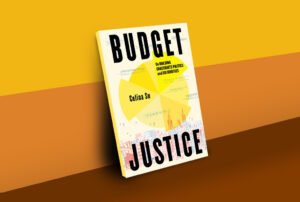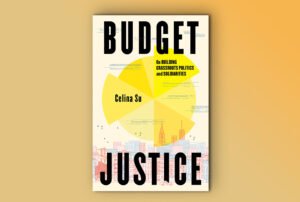
Editors’ note: This piece is from Nonprofit Quarterly Magazine’s summer 2024 issue, “Escaping Corporate Capture.”
How do we confront corporate capture in our work? Corporate capture can be found throughout our economy and society, but how it shows up differs depending on where one sits. In the essays that follow, three leaders consider the question in the areas of housing, climate work, and higher education. Tara Raghuveer, who directs the national Home Guarantee campaign, describes how the corporate capture of housing has helped to drive the nation’s current housing affordability crisis. Johanna Bozuwa, the executive director of the Climate and Community Project, details how the corporate capture of climate policy has impeded the public’s ability to respond effectively to the climate crisis. Davarian Baldwin, a professor, urbanist, historian, and cultural critic who has written widely about universities, delineates how the corporate capture of higher education has harmed university life and culture.
They offer solutions. For Raghuveer, the key institution that will help us move beyond corporate capture is federal regulation and tenant unions. Bozuwa sees great promise in continuing to develop countervailing power—as demonstrated over the years by the climate movement—and developing institutions and change at the level of community, the workplace, and the public sector. Baldwin, like Raghuveer, sees unions as playing a critical role in escaping corporate capture, but he also points to a growing coalition at the grassroots level of students, adjunct faculty, researchers, service workers, tenants, and taxpayers.
The overall vision that emerges from these essays is hopeful—marked not just by a growing awareness of the problem of corporate capture but also by a growing resolve to confront it and construct a more democratic economy.
Corporate Capture and the Promise of Tenant Unions
by Tara Raghuveer
Today’s housing market is a catastrophic failure, shaped by the relentless prioritization of those who make money from our homes. This market forces millions of tenants to make impossible choices, such as between paying the rent and feeding their kids. The rent is too damn high: median rent is now $2,095, rent was 34 percent of average income in 2019 and 40.6 percent in 2023, and 11.6 million tenant households are extremely cost burdened, spending over half their income on rent.1
The conditions we experience in today’s housing market are in large part the outcome of ongoing corporate capture. Institutional investors have consolidated the rental market, buying up single- and multifamily housing across the country. Private equity is the dominant form of financial backing for the 35 largest owners of multifamily properties.2 The flood of capital has led to both large and small acquisitions, concentrating the market and maximizing landlords’ profits.3 RealPage, a corporation that sells software to the nation’s largest property managers, has colluded to artificially increase rents, using a price-setting algorithm.4 Many landlords have raised rents beyond the rate of inflation, rent gouging at every opportunity.5
Tenants are confronting [corporate] capture by organizing toward a world in which housing is guaranteed as a public good.
To protect their market position and fend off regulation, the industry lobby has made itself a fixture in Washington. The National Association of Realtors regularly spends more than any other lobby group: they dropped $82 million in 2022 and $52 million in 2023, mostly to oppose regulation and to advocate for federal support for their industry through financing and subsidies.6 The National Multifamily Housing Council, National Apartment Association, and other industry groups spend less than the National Association of Realtors but often align with their positions. Together, these industry groups buy the outcome that suits their bottom line. This excessive market consolidation threatens tenants, hyper-commodifying one of our most basic needs. Corporate landlords treat our homes as investments and our lives as line items in their budgets.
We should be regulating corporate capture; instead, our government has enabled it. The nation’s biggest “affordable housing” programs, such as the Low Income Housing Tax Credit, rely on the private sector to house the poorest people, the result of defunding public programs for decades. The government-sponsored enterprises Fannie Mae and Freddie Mac do $150 billion in business with landlords every year—financing their loans, and often with debt obligations that essentially, and sometimes explicitly, require landlords to hike rent in order to make mortgage payments.7
Tenants are confronting this capture by organizing toward a world in which housing is guaranteed as a public good,8 by campaigning for a regulatory agenda,9 and by building durable tenant unions10 to intervene in this business-as-usual. And tenants are organizing to win federal rent regulations, among other protections, as conditions of federal financing.11 Recently, tenants won the first of such regulations from the Biden administration: 10 percent annual rent-increase caps in the context of LIHTC-financed properties.12 This protection will apply to over a million tenant households. The LIHTC cap itself, much higher than the 3 percent cap that tenant groups favor, is less significant than the regulatory mechanism used to implement it, which sets a precedent for similar conditions across other federal subsidies and financing programs.
Beyond a regulatory agenda, tenant unions are the most effective tool for combating corporate capture and securing homes for everyone.13 Tenant unions are not a new concept. Unions are an intuitive arrangement: knowing our neighbors, sharing our resources with one another—this has been a means of survival across cultures and through time. But today, tenants are up against more potent forces than ever, and tenant unions must commit themselves to experimentation and refinement, developing new methodologies to wield a new kind of power. Tenant unions in places like Kansas City, MO, and Louisville, KY, are beginning to do just that, establishing strategies to meet the scale of the crisis and evolving challenges. There is a lot of work to do to develop a practice of tenant organizing that meets the needs of our moment. But unions, like those named here, are working to change that, uniting across geography and aligning methodology to manifest their fullest potential.
Losing the Carbon Economy: Corporations’ Grief Cycle as the Climate Movement Advances
by Johanna Bozuwa
Faced with losing their carbon economy, corporations are in a grief cycle—but a new, more just economy can be born.
Corporations have deeply influenced the contours of the climate crisis and the world’s collective response. The primacy of profit and growth in the world economy—stewarded by corporations—has been the great driver of ecological breakdown, ever-higher emissions, and expanding numbers of communities counted as sacrifice zones. However, the climate movement is gaining ground in fits and starts, pushing for more action as the effects of the climate crisis become all the more real. Faced with losing their carbon economy, corporations are in a grief cycle—but a new, more just economy can be born.
Up first in the grief cycle is denial. Corporations, in particular fossil fuel corporations, have waged fierce—and effective—climate denialism (and delayism) campaigns over decades, building a muscular network of universities, scientists, political figures, and front groups to sow doubt about the climate crisis and stop climate legislation and regulation. One of the best-known examples of such outright denial strategy is that of ExxonMobil, which in the 1970s already knew about the adverse impacts of its business operations on the climate, yet, and to this day, actively fights against climate advocacy.14 In 2021, Greenpeace released videos of Exxon’s senior director of foreign relations speaking about the company’s strategy to undermine the climate elements of the infrastructure bill.15 The plastics industry and corporations like Coca-Cola also work to stop regulatory and/or other more comprehensive action against the ecological damage of their single-use plastics—running the Keep America Beautiful campaign, for example, which redirected the responsibility of the impact of their products on the environment onto consumers.16
Next, anger. As climate activists have become more effective at shutting or slowing down gas pipeline development, corporations have countered by using their political and monetary power to discipline activists with litigation and criminalization. For example, after Standing Rock, the Indigenous-led pipeline resistance camp against the Dakota Access Pipeline,17 the American Legislative Exchange Council18 and fossil fuel companies banded together to develop and pass legislation in 19 states that makes interfering with “so-called critical infrastructure” like gas pipelines a felony charge.19 And fossil fuel companies are disciplining whole countries trying to limit extraction via new policies by suing them for their potentially lost profits.20
Sign up for our free newsletters
Subscribe to NPQ's newsletters to have our top stories delivered directly to your inbox.
By signing up, you agree to our privacy policy and terms of use, and to receive messages from NPQ and our partners.
Then comes bargaining. Here, corporations bargain with the public by putting into place schemes designed to trick people into believing that these companies are taking action against climate change and giving them a pass. One way they’ve done this is via net-zero carbon plans, which allow corporations to offset their carbon emissions (by planting trees, for instance) instead of eliminating or at least minimizing their emissions.21 These offset schemes have been exposed as just another new way for companies to financialize the transition from fossil fuel.22
Last, there is acceptance. Corporations have begun to accept that the green transition is happening and therefore want to profit from it. An example: The car industry got a massive boost in the most recent infrastructure package, with major incentives for electric vehicle production. The Big Three automakers have used this as an opportunity to locate their EV operations in southern right-to-work states, and attempted to erode the union power that the United Auto Workers have built through decades of organizing23 (though the union’s recent win in a Tennessee plant shows that workers won’t take this lightly24). Another example is the increasing number of corporations that are profiting via greenwashing—the art of cultivating a green façade with the aim of placating people’s environmental and climate concerns. This allows them to take not only the shallowest of structural actions but also to profit—by bringing more sustainably minded consumers into the fold. An example of this is when a company advertises a product as being “green” without any proof via third-party testing.
The grief cycle is not linear; in fact, one can go through more than one stage at a time. And that is what is happening with corporations. They are trying to prove that climate change is a fiction (denial), making deals with policymakers and the public (bargaining), fighting against climate legislation and frontline activists (anger), and, after not succeeding in quashing the true state of affairs, touting themselves as green actors and profiting from both the carbon and green economies at the same time (acceptance).
We can build our own pillars of power that have the ability to discipline corporations and facilitate an economy fixed on the wellbeing of the planet and its denizens instead of on one that profits corporations.
So, how does a movement contend with this pernicious influence of corporations on the future of our habitable Earth? We can build our own pillars of power that have the ability to discipline corporations and facilitate an economy fixed on the wellbeing of the planet and its denizens instead of on one that profits corporations. We can build political power by eliminating corporate influence in politics that allows corporations to regulate their regulators. For instance, the No Fossil Fuel Money Pledge became a major litmus test for Democratic presidential hopefuls in 2019, and it continues to be a useful disciplinary tool in the present.25 We can build community power that creates communities of care in lieu of isolated individualism. For example, across the United States, renters are rising up and fighting for better, greener, more affordable housing, and a new movement has emerged to decommodify green housing.26 We can build public power that counteracts the decades of austerity that have emaciated public institutions. The SAGE Development Authority, for example, a 100 percent Native-led public power administrator dedicated to “self-determination for the Standing Rock Sioux Tribe,” is building a wind farm to power their community.27 We can build worker power that regulates corporations’ relationship to workers and communities and ensures that the jobs of the green transition are good jobs. The United Auto Workers, for example, has won protections for GM’s battery plant workers.28
In short, the key to counteracting corporate capture in the climate crisis is building a multiracial working-class base that is unwilling to entertain corporations’ grief cycle over losing their carbon economy. We can birth a new kind of economy—one that prioritizes decommodified basic services, self-determination, collective care, and worker solidarity.
The Corporate Capture of Higher Education
by Davarian L. Baldwin
Higher education’s “corporatization” has been a topic of discussion and debate for quite some time. As early as 1967, Senator J. William Fulbright railed against what he called the “military–industrial–academic complex,” during the growing wartime intimacy among government, the defense industry, and university life.29 And the impact of industrial or for-profit ambitions on university life would only accelerate and intensify in the years to follow.
Public and private schools receive public support, whether it’s the direct infusion of capital for annual budgets and federal research grants or the indirect support from tax exemptions on endowments and campus land, alongside once heavily subsidized student loans. But starting in the 1970s, we witnessed a broad process of defunding, this time for a sociopolitical rationale that would accelerate the corporate capture of higher education. School leaders and lawmakers began to ring the alarm about the growing presence and politics of women, the working class, and students of color,30 fearing what Ronald Reagan’s education adviser called the “danger of producing an educated proletariat.”31 Part of the response was to increase selectivity by both charging tuition and having tuition assistance come through federally insured private loans.
At the same time, we witnessed an enormous reduction in state contributions for the annual operating budget of public universities, from 70 percent in the 1970s to as low as 4.3 percent in the 2020 to 2021 academic year,32 leading some to call these schools “public” in name only.33 This period of privatization has led some schools to not only look for other revenue streams but also to take on a for-profit, corporate outlook in their broader priority setting of higher education as an institution.34
It is in exposing the corporate capture of higher education that we find… the staging ground for understanding and fighting against our current conditions and creating new pathways for social transformation.
Today, the corporate capture of higher education takes many forms. The drop in government funding encourages schools to find ways to make profits or reduce costs, which means courting higher-paying out-of-state and international students, which betrays their charter agreements for schools to serve citizens in the state. This has left students prey to a series of private loan companies with much higher interest rates than those once offered by federal loans (and now often offered by federally insured private loans).35 At the same time, higher education has taken a for-profit approach to its hiring and support of university teachers, by drastically reducing tenure-track positions that could provide not only greater financial and employment stability but also the potential for a more robust academic freedom in politically turbulent times. The cheaper salaries and limited security that come with contingency have destroyed the security of tenure and converted almost 70 percent of university instructors into glorified gig workers.36 And during the current political moment, the gross reduction of tenured faculty has produced a chilling effect on political dissent with the greater option of immediate termination without cause.37 The increased desire for corporate funding, to offset diminished government contributions, also prioritizes STEM education (science, technology, engineering, and mathematics) over the humanities and social sciences, and steers classroom instruction almost singularly toward career readiness.
Schools also take on their own debt to compete with each other in an increasingly stingy student marketplace. Classrooms and laboratories are overshadowed by pricey five-star cafeterias, rock-climbing walls, and luxury townhouses as part of what has been called the “amenities arms race.”38 In the process, credit rating agencies, like Moody’s and Fitch, have become de facto governors whose rating scales have not only provided financial lifelines but also shape the highly coveted school rankings that attract paying students.39 And the metrics for these almighty ratings have less to do with teaching and learning than with the more profit-centered focus on branding strength, the ability to unilaterally raise tuition, and the weakness of faculty unions and tenure protections.40 Schools are also expanding their physical footprints, so that their nonprofit, tax-exempt properties become innovation corridors that shelter profits for private investors and extract labor from underpaid graduate students who bring their research to market through university-controlled technology transfer systems.41 To service and maximize the profits of these noneducational priorities, schools have become top heavy with vice presidents, CFOs, and executive staff, sometimes drawn directly from the corporate world.
But higher education’s explicit desire to become more entrepreneurial has also galvanized an increasingly coordinated series of responses that understand college campuses as vital sites of struggle for more democratic futures. We have witnessed a series of “strike waves” among university workers, from faculty and graduate researchers to support staff and even undergraduate students.42 There is a growing analysis around the intentional manufacturing of debt, both student and institutional.43 Communities are calling for various forms of university compensation, especially considering the wealth hoarding that comes from the tax exemptions afforded both campus properties and multi-million-dollar endowments.44 And of course, the recent protests around US complicity in the Israeli destruction of Gaza further amplify the connections. It is hardly incidental that demands for a ceasefire are tied to growing calls of “disclose and divest” vis-à-vis university endowments invested in Israel and war-related production supporting the current genocide.45 The connections are further amplified by the overwhelming police force deployed to stomp out student dissent and their physical encampments, because this all upsets Zionist donors as well as the largest fundraising period for universities: graduation. The common thread here is that capitalism and democracy are at odds, and while such values as critical thinking, faculty allyship, ethical investing, and so on are encouraged by higher education, they get in the way of universities serving as a vehicle for unhindered capitalism.
Ultimately, the growing tentacles of higher education’s corporate capture are actually making more and more visible the coordinated extractive power of today’s knowledge economy. And through this exploitation, students, adjuncts, researchers, service workers, tenants, and taxpayers are visualizing a common cause and a common enemy. Therefore, the corporate exploitation of higher education has become its own classroom for visioning labor and debt strikes, the common-ing of campus land, community-based planning and zoning boards, campus police abolition, democratically accountable financing and land-use assessments—and yes, the return of free education. It is in exposing the corporate capture of higher education that we find not a training ground for a careerist future but the staging ground for understanding and fighting against our current conditions and creating new pathways for social transformation.
Notes
- Yanling Mayer, “US Rent Affordability Drops to Lowest Level in Decades,” CoreLogic, October 2, 2023, corelogic.com/intelligence/us-rent-affordability-drops-lowest-level-decades/; and The State of the Nation’s Housing: 2023 (Cambridge, MA: Joint Center for Housing Studies of Harvard University, 2023).
- Chris Morran and Daniel Petty, “What Private Equity Firms Are and How They Operate,” ProPublica, August 3, 2022, propublica.org/article/what-is-private-equity; and Heather Vogell, “When Private Equity Becomes Your Landlord,” ProPublica, February 7, 2022, www.propublica.org/article/when-private-equity-becomes-your-landlord.
- Les Shaver, “Consolidation Intensifies in Multifamily Industry,” MFE, June 17, 2015, multifamilyexecutive.com/business-finance/business-trends/consolidation-intensifies-in-multifamily-industry_o.
- Heather Vogell (with data analysis by Haru Coryne and Ryan Little), “Rent Going Up? One Company’s Algorithm Could Be Why,” ProPublica, October 15, 2022, propublica.org/article/yieldstar-rent-increase-realpage-rent.
- Katherine Schaeffer, “Key facts about housing affordability in the S.,” Pew Research Center, March 23, 2022, www.pewresearch.org/short-reads/2022/03/23/key-facts-about-housing-affordability-in-the-u-s/.
- “Top Spenders,” OpenSecrets, accessed June 12, 2024, opensecrets.org/federal-lobbying/top-spenders?cycle=2022; and “Top Spenders,” OpenSecrets, accessed June 12, 2024, www.opensecrets.org/federal-lobbying/top-spenders?cycle=2023.
- “Memo: Understanding Housing Supply in Relationship to Rent Regulations,” Homes Guarantee, September 13, 2023, org/wp-content/uploads/Homes-Guarantee-Memo_-Housing-Supply-_-Case-Studies.pdf.
- A National Homes Guarantee (People’s Action, September 2019), com/wp-content/uploads/Homes-Guarantee-_-Briefing-Book.pdf.
- Ramenda Cyrus, “The Tenants Who Went to Washington,” American Prospect, February 9, 2023, org/power/2023-02-09-tenants-rental-housing-policy/.
- Tara Raghuveer and John Washington, “The Case for the Tenant Union,” Poverty & Race 32, 1 (January–March 2023): nonconsecutive pages spanning 1–18.
- Cyrus, “The Tenants Who Went to ”
- Rachel Siegel, “Biden administration to cap rent increases for some affordable housing units,” Washington Post, March 29, 2024, washingtonpost.com/business/2024/03/29/biden-rent-housing/.
- Raghuveer and Washington, “The Case for the Tenant ”
- Neela Banerjee, Lisa Song, and David Hasemyer, “Part I of the Award-Winning Series: Exxon’s Own Research Confirmed Fossil Fuels’ Role in Global Warming Decades Ago,” Inside Climate News, accessed June 5, 2024, org/project/exxon-the-road-not-taken/.
- Jeff Brady, “Exxon Lobbyist Caught On Video Talking About Undermining Biden’s Climate Push,” NPR, July 1, 2021, npr.org/2021/07/01/1012138741/exxon-lobbyist-caught-on-video-talks-about-undermining-bidens-climate-push.
- Sam Davis, “The Keep America Beautiful Campaign and Greenwashing,” Dogwood Alliance, June 3, 2022, org/2022/06/the-keep-america-beautiful-campaign-and-greenwashing/.
- “ALEC: 50 Years of Attacking Environmental Protection and Democracy,” Greenpeace, October 3, 2023, greenpeace.org/usa/alec-50-years-of-attacking-environmental-protection-and-democracy/.
- “Critical Infrastructure Protection Act,” American Legislative Exchange Council, accessed June 5, 2024, org/model-policy/critical-infrastructure-protection-act/.
- Naveena Sadasivam, “Welcome to Utah, where pipeline protests could now get you at least five years in prison,” Grist, March 21, 2023, org/protest/utah-critical-infrastructure-law-felony/.
- Kyla Tienhaara et , “Investor-state disputes threaten the global green energy transition,” Science 376, no. 6594 (May 2022): 701–3.
- “Greenwashing—the deceptive tactics behind environmental claims,” United Nations, accessed June 5, 2024, un.org/en/climatechange/science/climate-issues/greenwashing.
- Angus Chapman and Desné Masie, “Are carbon offsets all they’re cracked up to be? We tracked one from Kenya to England to find out,” Vox, August 3, 2023, vox.com/23817575/carbon-offsets-credits-financialization-ecologi-solutions-scam.
- Nathaniel Meyersohn, “Electric vehicle jobs are booming in the anti-union UAW is worried,” CNN, last modified September 20, 2023, www.cnn.com/2023/09/20/business/uaw-jobs-south-auto/index.html.
- Nick Niedzwiadek, “UAW conquers hostile political terrain with Tennessee win,” Politico, April 20, 2024, politico.com/news/2024/04/20/uaw-volkswagen-tennessee-00153486.
- Emily Atkin, “Why Won’t These Democrats Reject Fossil Fuel Money?,” New Republic, March 19, 2019, com/article/153336/democrats-refuse-sign-no-fossil-fuel-money-pledge.
- Jacob Carlson and Gianpaolo Baiocchi, “Social Housing: How a New Generation of Activists Are Reinventing Housing,” NPQ, June 6, 2023, nonprofitquarterly.org/social-housing-how-a-new-generation-of-activists-are-reinventing-housing/.
- “Our Purpose,” SAGE, accessed June 5, 2024, org/our-purpose/; and “Help us leave a legacy on our native land,” Anpetu Wi Wind Farm, accessed June 5, 2024, anpetuwi.com/. (Also, New York passed the New York State Build Public Renewables Act in 2023, which emboldens their statewide public power provider, the New York Power Authority, to become a leader in the state’s energy transition.)
- Julia Conley, “‘Unbreakable Solidarity Is Working’: UAW Wins Protections for GM Battery Plant Workers,” Common Dreams, October 6, 2023, commondreams.org/news/uaw-gm-national-agreement.
- “Nicholas Turse: The Military-Industrial-Academic Complex,” History News Network, accessed June 6, 2024, historynewsnetwork.org/article/nicholas-turse-the-military-industrial-academic-co; and “Nick Turse arm-wrestles the Military-Academic Complex,” TomDispatch (blog), April 27, 2004, tomdispatch.com/nick-turse-arm-wrestles-the-military-academic-complex/.
- See Ellen Schrecker, The Lost Promise: American Universities in the 1960s (Chicago: University of Chicago Press, 2021).
- Jon Schwarz, “The Origin of Student Debt: Reagan Adviser Warned Free College Would Create a Dangerous ‘Educated Proletariat,’” The Intercept, August 25, 2022, com/2022/08/25/student-loans-debt-reagan/.
- Danielle Douglas-Gabriel, “College tuition is getting more Here’s who’s actually to blame.,” Washington Post, April 7, 2015, www.washingtonpost.com/news/wonk/wp/2015/04/07/college-tuition-is-getting-more-expensive-heres-whos-actually-to-blame/; and Mary Ellen Flannery, “State Funding for Higher Education Still Lagging,” NEA Today, October 25, 2022, www.nea.org/nea-today/all-news-articles/state-funding-higher-education-still-lagging.
- Flannery, “State Funding for Higher Education Still ”
- See Charlie Eaton, Bankers in the Ivory Tower: The Troubling Rise of Financiers in US Higher Education (Chicago: University of Chicago Press, 2022); and Sheila Slaughter and Gary Rhoades, “The Neo-Liberal University,” New Labor Forum, no. 6 (Spring–Summer 2000), 73–79.
- We have seen a drastic reduction in federally subsidized loans and a dynamic uptick in both private and federally insured private loans, with much higher interest rates and financial demands (i.e., the rates are not fixed). But the interest rates are still higher than with federal loans and the rates are not fixed on private loans, federally insured or not.
- Glenn Colby, Data Snapshot: Tenure and Contingency in US Higher Education (Washington, DC: American Association of University Professors, March 2023).
- Reshmi Dutt-Ballerstadt, “An Extraordinary Firing,” Inside Higher Ed, June 3, 2021, insidehighered.com/views/2021/06/04/universities-fire-tenured-faculty-without-due-process-are-setting-dangerous.
- Cara Newlon, “The College Amenities Arms Race,” Forbes, last modified January 8, 2021, forbes.com/sites/caranewlon/2014/07/31/the-college-amenities-arms-race/.
- Eleni Schirmer, “It’s Not Just Students Drowning in Colleges Are Too!,” The Nation, November 20, 2020, www.thenation.com/article/society/student-debt-university-credit/.
- Ibid.
- See Davarian Baldwin, “‘Educational Purposes’: Nonprofit Land as a Vital Site of Struggle,” Nonprofit Quarterly Magazine 30, no. 2 (Summer 2023): 22–33.
- Robert Iafolla, “College, University Strike Wave Continues Its Swell Into 2023,” Bloomberg Law, January 24, 2023, bloomberglaw.com/daily-labor-report/college-university-strike-wave-continues-its-swell-into-2023.
- Chris Thompson, “A Student-Debt Researcher Fucks Me Up With America’s Broken Promises,” Defector, December 8, 2020, com/a-student-debt-researcher-fucks-me-up-with-americas-broken-promises.
- Davarian Baldwin, “Universities and Cities: Why We Must End the Nonprofit Path to Wealth Hoarding,” NPQ, December 22, 2021, org/universities-and-cities-why-we-must-end-the-nonprofit-path-to-wealth-hoarding/.
- Solcyré Burga and Nik Popli, “Protestors Are Calling on Universities to Divest from Israel: Here’s What That Means,” TIME Magazine, May 2, 2024, com/6974063/divestment-explained-campus-protest-israel/.











